|
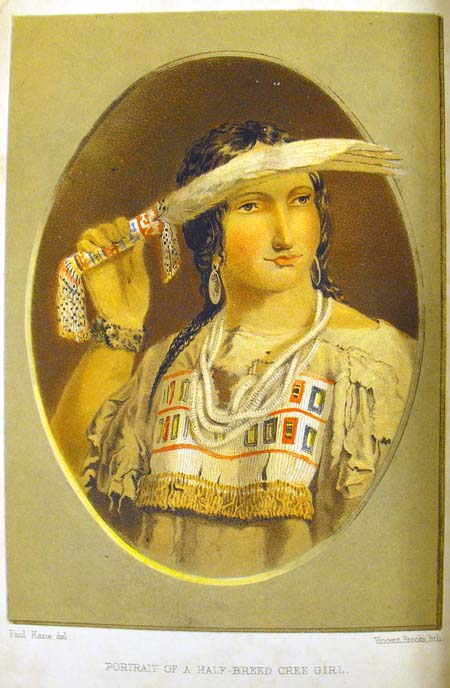
Frontispiece of the book: lithograph of one of Kane's oil
paintings
depicting 'A Half-Breed Cree Girl' |
Paul Kane's Wanderings of an artist among
the Indians of North America: from Canada to Vancouver's Island and
Oregon through the Hudson's Bay Company's territory and back again
is modest in appearance, yet it has
an interesting and important place in the history of Canadian art and
ethnography. It is a complicated work, combining elements of travel
literature, ethnography and art. In it, Kane records the incidents and
interactions he has with both white and aboriginal peoples in the
western parts of what is now Canada and the north western parts of what
is now the United States.
The copy seen here is a first edition, published in 1859 by Longman's
of London. It is 455 pages, illustrated by eight coloured lithographs
and thirteen wood engravings. There is also an appendix which includes a
census of aboriginal tribes. Our copy of this interesting volume is
from the library of the renowned artist
James McNeill Whistler.
|
|
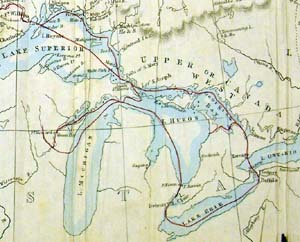
Close-up of map showing the area in which
Kane spent much of his childhood
(tipped in before chapter 1) |
|
Paul Kane (1810-1871) is widely considered to be Canada's first artist of
national significance. Historian R. Douglas Francis argues that "few
Canadian artists have received greater attention than Paul Kane"1. Several books have been written about his art and life.
At one time, Kane's work was valued for both its artistic and
ethnographic merit. In the mid-fifties, Nancy Wilson writing in the
American Heritage, argued that "probably no other artist except George Catlin ever left such a complete and accurate record of the forms, the
faces, and the way of life of this continent's aborigines"2.
|
|
|
|
Historian J. Russell Harper argued that "ethnologists find a wealth
of information in his portrayal of the life and customs of the native
peoples"3. But in the ensuing years, historians and art critics
have brought to light some problematic aspects of the work and its
author. Wanderings challenges us to ask several important
questions: how much of Wanderings is actually in Kane's own
voice? how accurately did Kane portray, in his writing and his art, the
aboriginal groups he met? does his art represent an emergent,
distinctive, Canadian style?
Paul Kane was born in Mallow, County Cork, Ireland in 1810 and
emigrated to York (Toronto) with his family in 1819. His early school
records have not been found, but there is evidence suggesting that he
learned to paint from an art teacher employed at York's prestigious
Upper Canada College. As a young adult, he found work as a decorative
painter in a York furniture factory. By the age of twenty-three or
twenty-four he had decided that his career would be in fine art. He
painted portraits for a number of years, both in Canada and in the
United States, from about 1836 onwards. In 1841, he made the journey to
Europe to develop his art. He studied and copied the works of the
masters in Italy, and then moved on to Switzerland, France and England.
It was in England that Kane met George Catlin, the man who would,
without exaggeration, change the course of his life.
|
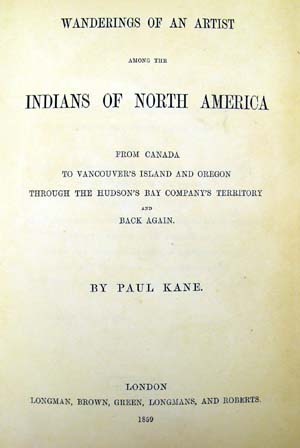
The book's title page |
| American artist George Catlin
was generating great, and perhaps somewhat lurid, interest in the
aboriginal peoples living in the mid and northwest of the United
States. His book, Letters and notes on the manners, customs and
conditions of the North American Indians, published just prior to
his arrival in England, found an immediate audience.
He argues in the book that the imminent extinction of aboriginal
peoples demanded that someone record their images and customs before
they were lost to time, war and disease. The book acted as publicity
for an exhibition with accompanying lectures that he had organised
in the Egyptian Hall, Piccadilly. The English daily press advanced
his cause with some sensationalist reporting. His exhibition included
portraits, clothes, sacred and everyday objects and live aboriginal
models! A reporter in the Times notes "Mr. Catlin proceeds to exhibit a series of
tableaux vivans, by 20 living figures arrayed in beautiful Indian
costumes . these tableaux are arranged with most picturesque and
thrilling effects"4 and concludes that
"the exhibition is of a deeply interesting and at the same time
instructive character"5. In another
article the Times recorded that the "numerous portraits are full
of character . the views of combat are very full of spirit and
exhibit modes of warfare and destruction horribly illustrative of
savage life"6. |
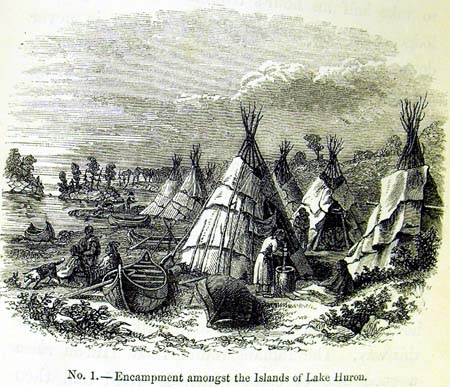
Encampment amongst the islands of Lake Huron
(illustration, p. 7) |
|
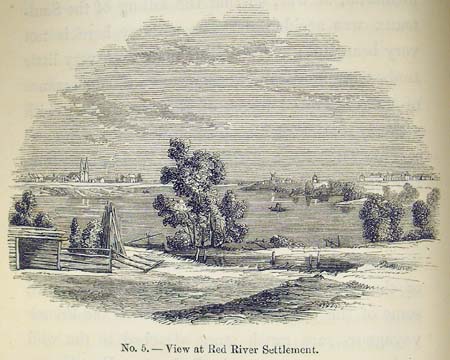
View at Red River Settlement
(illustration, p. 74) |
Kane was completely
taken with Catlin's project and decided that his own artistic mission would
be the accurate and complete recording of aboriginal life in Canada. He
was determined to keep a journal (which would form the basis of
Wanderings of an artist) just as Catlin had, sketch furiously on his
long travels and then, from the comfort of his studio in York, produce
formal canvases of selected individuals and events. Now, all that Kane
required was a route and a detailed plan of action.
For Kane to undertake such a journey any number of factors had to be
taken into consideration: finances, guides, lodging, and equipment. The
territory beyond settled Upper Canada was vast and much of it was then
under the control of the Hudson's Bay Company. Special permissions to
join soldiers and hunters would have to be sought. From 1843 (when he
first met Catlin in London) to 1845, Kane made preparations for this
adventure. |
|
On 17th June 1845 Kane packed up his artists' materials as
well as his gun and headed into the "pathless forest" to see "the
aboriginals of this country in their original state"7 and "study their
native manners and customs"8. For several years Kane would
travel for lengthy periods into the territories beyond Upper Canada -
going to Sault Ste Marie, Fort Garry (now Winnipeg), Fort Assinibione,
Fort Edmonton, Jasper in the Rocky Mountains, Oregon, Washington and
Fort Vancouver (today Vancouver, Washington), Vancouver Island, and
Walla Walla.
He encountered many different aboriginal nations / groups,
including the Ojibwa, Ottawa, Menominee, Wyandot, Potawatomi, Salteux,
Metis, Cayuse, Nez Perces, Colville, and Cree. During this time, he kept
a rather terse diary of his travels. This diary - which was to form the
basis for Wanderings - is very interesting to say the least and
perhaps raises
questions about the authorship of the published work. |
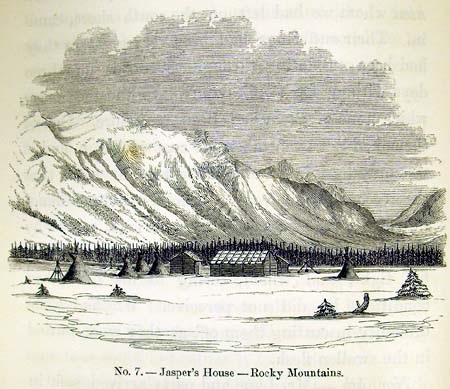
Jasper's House - Rocky Mountains
(illustration, p. 154) |
|
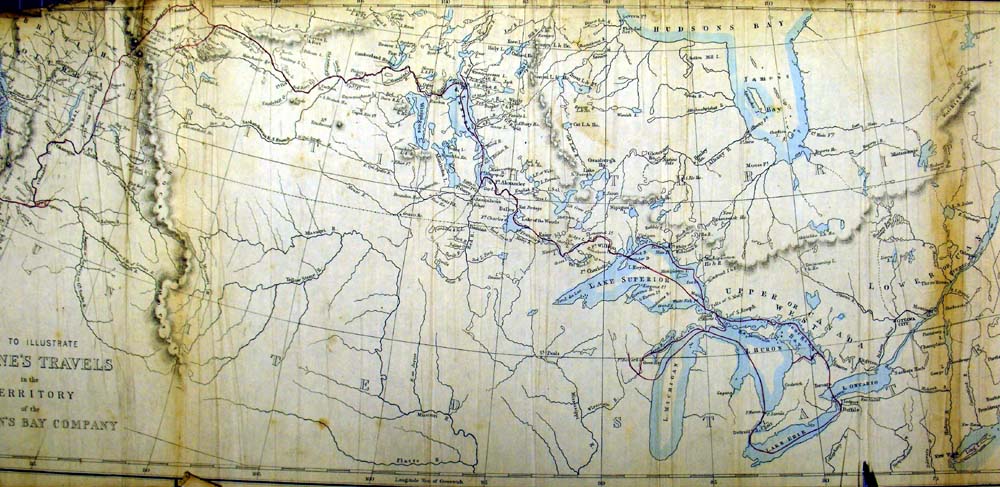
Map showing the route
Kane took across Canada
(tipped in before chapter 1) |
| A scholar of Kane's work, I.S. MacLaren, tracked down the diary from
which the much longer Wanderings is based. Kane's diary, written
from 1846 to 1848, has about 260 dated entries. Some entries are
only two or three words and most are between seven to fifteen sentence fragments.
The diary itself is "breastpocket-sized"9
with 72 leaves.
There is a vast disparity between the diary entries and those
entries published in Wanderings. For two entries dated March 1847, Kane
jots down these few words: "with 2 men in a canew bound for victoria at
4 P.M. and camped at the mouth of the willhamed 5 mil. 26th made a
sketch of Mount St. Hellans from the entrans to chalefews Lake and campt
3 P.M. at Coffin Rock 4 mils above the mouth of the Coulitz R"10. The brevity of the notes is obvious, as is the curious
and inconsistent spelling of common words (Kane was a phonetic speller
and even simple words like "ice" are misspelled as "ise"). What is also
notable is the matter-of-factness of the writing. There is little
embellishment or even narrative. It is the briefest description of two
days and no mention is made of aboriginal people. |
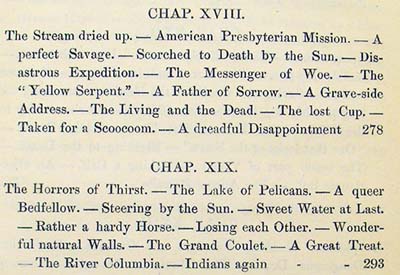
Extract from list of contents
|
|
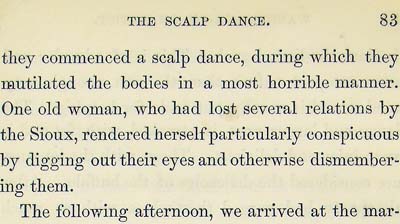
A gruesome and sensational description of scalping
(p. 83) |
If we turn to
Wanderings, there is an entirely different character to
the writing. It states: "[when] we arrived at the mouth of the Kattlepoutal River, twenty-six miles from Fort Vancouver, I stopped to
make a sketch of the volcano, Mount St. Helen's, distant, I suppose,
about thirty or forty miles. This mountain has never been visited by
either Whites or Indians; the latter assert that it is inhabited by a
race of being of a different species, who are cannibals, and whom they
hold in great dread ."11.
And it later states ". about ten miles lower down we encamped for
the night near Coffin Rock, much against the inclination of my men,
whose superstition would have led them to avoid such a place"12.
In this much more elaborate version of the events,
we have a sensationalistic rendering of what was supposedly encountered.
This version panders to a British or European reader who expects a man
or woman from an aboriginal group to be exotic in appearance and
beliefs. Superstitions, cannibalism and mysteriously haunted places all
work together to distance the Nisqually (the group/tribe that Kane is
referring to in his text) from the realm of a new settler living in
Upper Canada or the United States, or a Briton still living in the UK.
This version of events was made to sell. |
|
MacLaren,
alluding to the tastes of the average mid-Victorian Briton,
notes that "in a highly competitive British or American travel
literature market, publishing houses had very acute senses of the timbre
and tone, the shape and the style necessary to guarantee brisk sales of
a work of travel writing . in the idioms of the day, Indians had to be
savages, artists . had to be gentleman, and landscapes . had to be made narratively comprehensible to the armchair traveller"13.
MacLaren's conclusions do ring true when looking at the journalistic
reviews of George Catlin's work. In the Times, the reporter argued
"[a]ccident, perhaps, has given a development to the intellectual
faculties of the white races which has clothed them with a superior
moral power."14.
Later in the article, the reporter would describe aboriginal peoples
as "unsophisticated children of nature, fresh from their native
wilds"15.
For Wanderings to sell, the
publisher obviously thought that Canada's aboriginal peoples had to be
portrayed in a manner similar to those in Catlin's America. In The
Athenaeum, the reviewer directs the reader's attention to the
savagery in Wanderings. The review states "[it] is
humiliating to proud nature to observe how rapidly starving men,
whether English sailors or Indian braves, resort to cannibalism . of
the degradation and crime that it entails, he tells a horribly
interesting story"16.
|
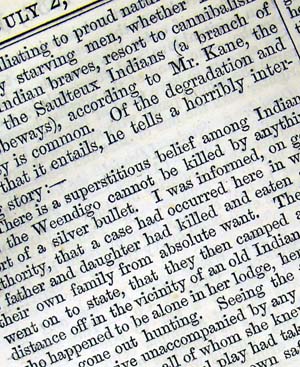
Extract from review in The Athaeneum |
|
|
|
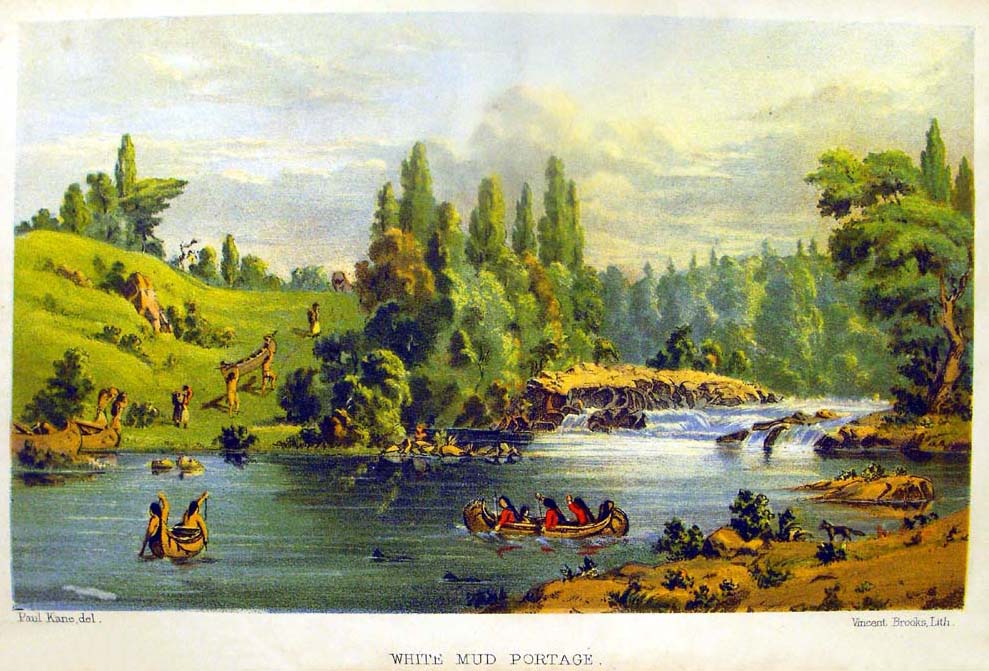
White mud portage
(lithograph facing p. 443) |
Over the course of the article, the reviewer exhausts the catalogue
of stereotypes; alighting on the topic of aboriginal drunkenness,
violence (more specifically matricide), bodily modifications,
childlike naivety, and strange rituals. So, in Wanderings,
the reader is not privy to Kane's original observations of
aboriginal life, instead she or he is given a highly embroidered,
fanciful account of what publishers' thought readers expected. While
most scholars believe the core of Wanderings is in Kane's voice, a
few others raise questions about its entire authorship. The strongest
proponent of this alternate position is MacLaren, who
speculates that the true authors of Wanderings were three editors who
completely re-worked the diary. MacLaren finds it disappointing that
Kane's own words were not used as they were much more measured.
|
|
With the publication of Wanderings, Paul Kane had finished only
parts one and two of his great Canadian aboriginal project. The
diary was finally published, though it had taken ten years to do so.
He had sketched hundreds of people, objects, and landscapes during
the journey - by his account recording exactly what he saw.
|
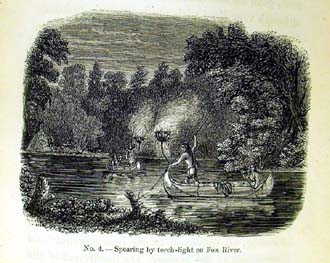
Spearing by torch-light on Fox River
(illustration, p. 31) |
The third part of the project was to paint formal canvases from
the quick sketches made in the field, just as Catlin had done.
Because it took so long to get the diary
published, several of the formal canvases were already finished and were
available to be included in Wanderings. Four of these, "Portrait of a
half-breed Cree Girl", "Flat-head Woman and Child", "Portrait of Kee-akee-ka-saa-ka-wow
with Pipe-stem", and "White Mud Portage" appear in the book as
coloured lithographs.
|
|
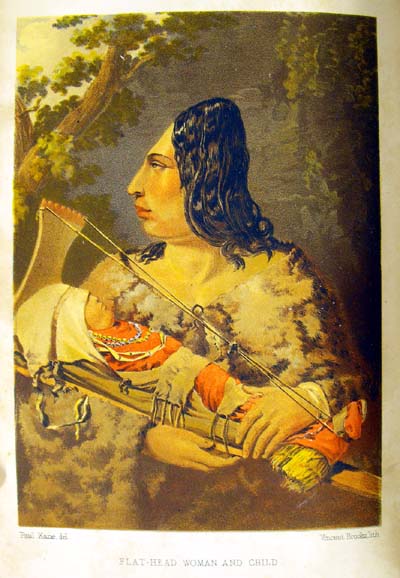
Flat-head woman and child
(lithograph facing p. 205) |
Thirteen of the quick sketches, reproduced as woodcuts, were also
included in the book. Art historians have identified a significant difference in the
sketches that were made during the period Kane kept his diary and the
one hundred or so canvases that he would paint from them over the next
few decades. The difference has been explained as a function of Kane's
differing sense of his identity in the field versus the studio. In the
field, he is the "recorder" of what he sees. In the studio, he is the
"interpreter", bringing his own and his culture's sensibilities to the
art17.
The sketches, drawn quickly and on site, are considered
by some experts as fairly accurate representations of the scenes and the
people that he encountered. Art historians Ann Davis and Robert Thatcher
note that the sketches are "spontaneous" and "bright"18. MacLaren, however, casts doubts on the accuracy of the sketches.
Assuming the dates of Kane's diaries are correct, he notes that the trip
from York Factory to the Pacific Ocean was done at break-neck
speed with few stops. He concludes that "it seems a wonder that
Kane saw anything or anyone long enough to make a sketch"19.
The paintings made from these sketches, though part of a
monumental project, do not reveal a new, Canadian style of
painting. Indeed, Davis and Thacker believe that the art of Catlin and
Kane was heavily influenced by the romantic movement in Europe -
two of the significant aspects of romanticism being a "fondness
for the exotic" and the "observation of nature"20.
|
|
In the paintings of hunting, fishing or ceremonial scenes,
Kane looks to European masters for clues to creating the most
arresting composition and mood. Kane "consciously adopts
romantic artistic conventions and presents the environment as a
vital component, incorporating great banks of stormy clouds,
dramatic patches of sunlight, and carefully executed details of
flora - all contributing in an important way to the total
effect"21. Much of the landscape in his paintings is in
soft focus - much more atmospheric than realistic. The features
of the landscape and trees are not so finely rendered as to make
them discernible as a particular type or to mark them as
distinctly "Canadian". The portraits especially "interpret"
aboriginal people in a manner sympathetic with British and
continental views of the "exotic other".
Kane would add or modify objects or clothing in the painting,
perhaps to make his subject appear more grand or interesting.
Looking at the paintings, a modern-day observer might note that the
faces of the subjects lack individuality whereas there seems to be
more care taken to differentiate the clothing and cultural
paraphernalia. There is a same-ness in the tones and poses that give
the works a certain banality.
There is no doubt, however, that Paul Kane did something spectacular and amazing, travelling the length of
a huge continent, several times, in rough terrain and with few comforts,
to record what he saw. In Wanderings, he writes that the
motivation came from a concern for the "Indians" that were
disappearing. Does his body of work give us the "truth" of
aboriginal life in that era? His diary,
Wanderings, sketches, and paintings do open a window on the
westerner's view of aboriginal life in a certain place and from
a certain time. American historian David Hunt writes that "'for
all the attempts to render an accurate view or produce a
believable report, the majority of the artists on the western
frontier envisioned and perpetuated what we think of today as a
romance'"22.
Wanderings
certainly reveals more about what westerners thought than what
aboriginal people were. It is a flawed but interesting account of one
mid-19th century adventure and the sketches and paintings that
came out of it are useful albeit problematic artefacts of that era.
|
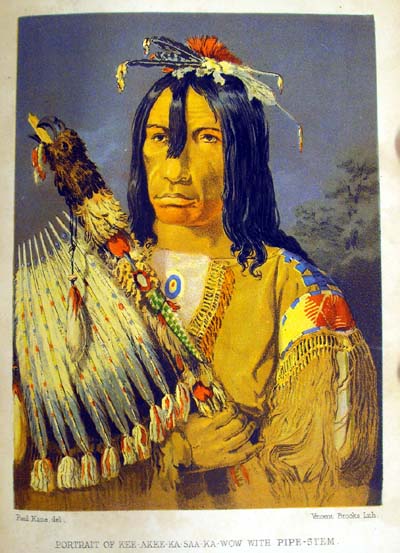
Portrait of Kee-Akee-Ka-Saa-Ka-Wow with pipe
stem
(lithograph facing p. 402) |
This article was written by Kalina Grewel, a librarian
from York University, Toronto, while on a work placement at the
University of Glasgow Library. |
Other items of interest:
Bartlett, W.H. Canadian scenery illustrated. London: N.P. Willis,
1842. Level 12
Spec Coll BD6-e.4 vol. 1 & 2
Hassrick, Royal B. The George Catlin Book of American Indians. New
York: Promontory Press, 1981.
Level 11 Main Lib
Fine Arts CN405 HAS
Paul Kane goes west. Dir. Gerald Budner. National Film Board of
Canada,1972.
Visions from the wilderness: the art of Paul Kane. Dir. John Bessai.
Bravo!, 2001.
West, John. The substance of a journal during a residence at the Red
River Colony, British North America: and frequent excursions among the
North-west American Indians, in the years 1820, 1821, 1822, 1823.
London: L.B Seeley and Son, 1824.
Library Research
Annexe T7-f.23
The following have
been useful in creating this article:
"Catlin's Indian Gallery, Egyptian Hall" The Times. April 19,
1841: 3. The Times Digital Archive [page accessed 12 December 2008]
http://infotrac.galegroup.com/itw/infomark/111/1/1/purl=rc6_TTDA?sw_aep=glasuni
Davis, Ann and Thacker, Robert "Pictures and Prose: Romantic
Sensibility and the Great Plains in Catlin, Kane, and Miller." Great
Plains Quarterly. 6. Winter (1986): 3-20.
Francis, R. Douglas. Review: Paul Kane's Great Nor-West The Canadian
Historical Review. 78.2 (1997): 293-294.
Level 8 Main Lib
History Pers CA350
Harper, J. Russell. "Kane, Paul." Dictionary of Canadian Biography
Online. 2000. 10 December 2008.
http://www.biographi.ca.ezproxy.library.yorku.ca/index-e.html
Kane, Paul. Wanderings of an artist among the Indians of North
America: from Canada to Vancouver's Island and Oregon through the
Hudson's Bay Company's territory and back again. London: Longman, Brown,
Green, Longmans, and Roberts, 1859.
Level 12 Spec
Coll Whistler 71
"Letters and Notes on the Manners, Customs and Condition of the North
American Indians. By George Catlin." The Times. Oct 14,
1841, p. 3. The Times Digital Archive [page accessed 12 December
2008]
MacLaren, I.S. "'I Came to Rite Thare Portraits': Paul Kane's Journal
of His Western Travels, 1846-1848." The American Art Journal 21.2
(1989): 7-22. Electronic Resource:
http://www.jstor.org/stable/1594539
MacLaren, I.S. "Journal of Paul Kane's Western Travels, 1846-1848."
The American Art Journal. 21.2 (1989): 23-62. Electronic Resource:
http://www.jstor.org/stable/1594540http://www.jstor.org/stable/1594540
"Mr. Catlin's Indian Gallery." The Times. 3 February, 1840: 5. The
Times Digital Archive. [page acessed 12 December 2008]
http://infotrac.galegroup.com/itw/infomark/111/1/1/purl=rc6_TTDA?sw_aep=glasuni
"Review: Wanderings of an artist among the Indians of North America:
from Canada to Vancouver's Island and Oregon through the Hudson's Bay
Company's territory and back again." The Athenaeum. 2 July 1859: 14-15.
Stack Gen Hum
Pers
Ross, Nancy Wilson. "Murder at the Place of Rye Grass." American
Heritage. 10. August (1959): 42-44, 85-91.
Library Research
Annexe Store Pm740 vol. 10
Ross, Nancy Wilson. "A Rich and Varied Indian Life." American
Heritage. 10. August (1959): 45-53.
Library Research
Annexe Store Pm740 vol. 10
References cited in text
1 Douglas Francis, p. 293
2 Ross, p. 45
3 Harper
4 Times, April 19th, 1841, p. 3
5 Times, April 19th, 1841, p. 3
6 Times, Feb. 3, 1840, p. 5
7 Kane, p. vii
8 Kane, p. vii
9 MacLaren, p. 13 and p. 20
10 MacLaren, p. 37
11 Kane, p. 200
12 Kane, p. 200
13 MacLaren, p. 12
14 Times, Oct 14, 1841, p. 3
15 Times, Oct 14, 1841, p. 3
16 Athenaeum, July 2, 1859, p. 15
17 Davis, p. 14
18 Davis, p. 14
19 MacLaren, p 19
20 Davis, p. 3
21 Davis, p. 7
22 Quoted in MacLaren, p. 14
Return to main Special Collections
Exhibition Page
Go to previous
Books of the Month
Kalina
Grewel June 2009 |